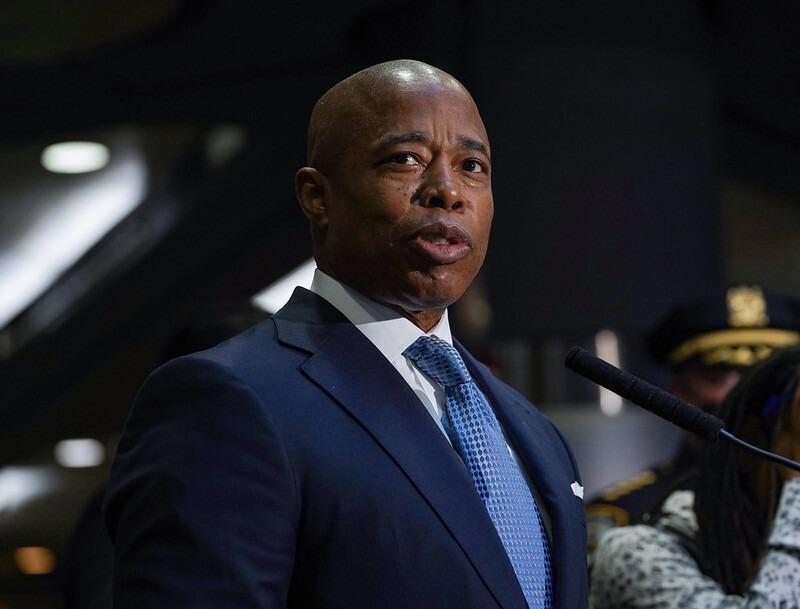NYC Advocates Fear More Police Violence, Homeless Criminalization Amid Forced Hospitalizations
New York City Mayor Eric Adams issued a directive this week that puts police at the center of renewed efforts to remove people exhibiting signs of mental illness from public spaces.

Advocates are raising alarm over New York City Mayor Eric Adams’ new directive targeting people with perceived signs of mental illness for removal and forced hospitalization. While Adams has said the policy is intended to help the city’s poorest and most vulnerable residents, community groups say the true intent is to disappear homeless people from the city’s streets and subways. They argue the new standards will only result in further criminalization and police violence against the unhoused population.
In February, the New York State Office of Mental Health published guidance clarifying that a person can be involuntarily hospitalized under state law if they appear to be mentally ill and display “an inability to meet basic living needs, even when there is no recent dangerous act.” At a press conference this week, Adams unveiled a memo stating that the city concurs with the state agency’s interpretation and directing police and peace officers to begin removing any individual who “appears to have mental illness and cannot support their basic human needs to an extent that causes them harm.”
Civil rights advocates say the directive’s vague language gives police carte blanche to detain unhoused people in New York, based on arbitrary and potentially inaccurate evaluations of their mental health. To officers, the mayor’s guidance serves as a “green light” that tells them, “You have my permission to do it, however you need to do it, to get [homeless people] off the street,” said Lisa Ortega, a community organizer with Take Back the Bronx, a grassroots activist collective.
Under the mayor’s plan, police officers will have prolonged contact with people prior to their hospitalization. The policy requires a peace or police officer to be present at the scene of all involuntary removal attempts to “ensure the individual stays on scene.” Officers must also “escort” emergency services personnel on trips to the hospital and ride in the back of the “transport vehicle.” The escorting officer can leave only after the person has been registered as a patient at the hospital.
The involvement of law enforcement in these potentially tense interactions only raises the likelihood of arrest and violence, said Rena Karefa-Johnson, who works with FWD.us, a criminal justice reform organization. (FWD.us provides funding to The Appeal. The Appeal lists all donations over $2,000 on its website and adheres to the Institute for Nonprofit News’s policies on editorial independence and donor transparency.)
“Increasing points of contact with police for communities like Black communities, unhoused communities, brown communities, disabled communities, queer communities, inevitably leads to increased criminalization and state violence,” she said.
Police in New York City and across the U.S. are notorious for having brutalized, traumatized, arrested, and killed the very people who they were called to help. Studies have shown that police are significantly more likely to use force against people with mental illness. A Washington Post investigation found that from 2019 to 2021, law enforcement killed close to 200 people who were experiencing an emotional or mental health crisis.
“Police are trained in command and control,” said Beth Haroules, a senior staff attorney with the New York Civil Liberties Union. “People who have a disability or are impaired in some fashion, they don’t respond simply to command and control.”
If an officer perceives an individual as aggressive or uncooperative during a removal attempt, they could face criminal charges, which would only entangle them in the legal system and make it harder for them to access housing and support. People in mental health crises routinely end up getting charged over encounters with police or medical personnel, according to a report published last year by Disability Rights New York and John Jay College of Criminal Justice.
Despite the well-documented risk that police pose to people with mental illness, the mayor’s directive does not limit the weapons or force an officer can use during these removals.
“If you don’t immediately comply with a police officer’s order or directive, the situation is immediately escalated,” said Yung-Mi Lee, Legal Director of Criminal Defense at Brooklyn Defender Services, a legal clinic that provides pro bono representation to low-income New Yorkers. “The police officer will just automatically try to put handcuffs on.”
Involuntary removals and hospitalizations are already traumatic and often “marked by physical conflict,” said Timothy Clune, executive director of Disability Rights New York. The mayor’s plan will only exacerbate these existing issues, affecting both people with mental illness and those simply perceived to be mentally ill.
“Given the lack of expertise of those designated to make a determination that one ‘appears to be mentally ill,’ there is a high likelihood that people with and without other such disabilities will be erroneously removed and detained,” Clune said in a statement to The Appeal.
Adams has insisted that his directive is an overdue and compassionate response to help people the city has discarded. But to truly help homeless people, they should be given access to housing and community-based services, said Ortega, who is formerly homeless.
“They make it seem like you cannot get well or get an apartment until you’re A, B and C. But it’s really the opposite way around,” she said. “If you give someone a stable place to put their head, then they become conducive to, ‘okay, maybe now we can move forward and recover.’ It doesn’t work the other way around. It just doesn’t.”
